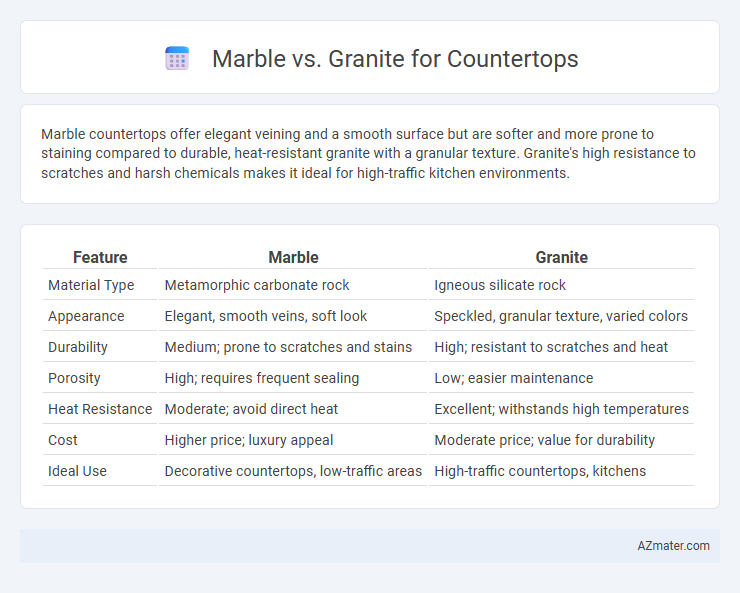Marble countertops offer elegant veining and a smooth surface but are softer and more prone to staining compared to durable, heat-resistant granite with a granular texture. Granite's high resistance to scratches and harsh chemicals makes it ideal for high-traffic kitchen environments.
Table of Comparison
| Feature | Marble | Granite |
|---|---|---|
| Material Type | Metamorphic carbonate rock | Igneous silicate rock |
| Appearance | Elegant, smooth veins, soft look | Speckled, granular texture, varied colors |
| Durability | Medium; prone to scratches and stains | High; resistant to scratches and heat |
| Porosity | High; requires frequent sealing | Low; easier maintenance |
| Heat Resistance | Moderate; avoid direct heat | Excellent; withstands high temperatures |
| Cost | Higher price; luxury appeal | Moderate price; value for durability |
| Ideal Use | Decorative countertops, low-traffic areas | High-traffic countertops, kitchens |
Introduction to Marble and Granite Countertops
Marble countertops are prized for their luxurious appearance and unique veining patterns, often crafted from metamorphic limestone, offering a classic and elegant aesthetic. Granite countertops, composed of hardened volcanic rock, provide exceptional durability and resistance to heat and scratches, making them ideal for high-traffic kitchen environments. Both materials require sealing to prevent staining, but granite's dense composition generally offers greater longevity and easier maintenance compared to marble.
Aesthetic Differences Between Marble and Granite
Marble countertops showcase unique veining patterns and a smooth, luxurious surface that enhances classic and elegant kitchen designs, while granite offers a more granular, speckled appearance with various colors and textures, providing a natural and robust look. The translucency of marble creates a luminous effect under light, making it ideal for bright, open spaces, whereas granite's dense composition lends a matte or polished finish that complements rustic or contemporary settings. Both materials offer distinct aesthetic appeals, but marble's softer, intricate patterns contrast with granite's bold, consistent motifs, influencing overall countertop style choices.
Durability and Longevity Comparison
Granite countertops exhibit superior durability due to their dense composition, making them highly resistant to scratches, heat, and stains compared to marble. Marble, while elegant, is softer and more porous, leading to increased susceptibility to etching, chipping, and wear over time. Granite's robust nature ensures longer-lasting performance, maintaining appearance and structural integrity in high-traffic kitchen environments.
Maintenance Requirements: Marble vs Granite
Granite countertops exhibit high durability and resistance to scratches and stains due to their dense, non-porous nature, requiring minimal maintenance such as periodic sealing every 1 to 3 years. Marble countertops demand more frequent upkeep because their porous surface is prone to etching, staining, and scratching, necessitating regular sealing and immediate cleaning of spills to preserve their aesthetic appeal. Comparing maintenance requirements, granite offers a more resilient and low-maintenance option, while marble requires diligent care to maintain its natural beauty.
Cost Analysis and Budget Considerations
Granite countertops typically range from $40 to $100 per square foot, offering a durable and cost-effective option compared to marble, which can cost between $50 and $150 per square foot due to its luxurious appearance and higher maintenance requirements. Budget considerations must include not only the initial material and installation costs but also long-term expenses such as sealing and repairs, with granite generally demanding less upkeep and lower maintenance costs than marble. Homeowners seeking a balance between elegance and affordability often select granite for its resilience and overall value in kitchen and bathroom countertops.
Stain and Scratch Resistance Factors
Granite countertops offer superior stain and scratch resistance compared to marble, making granite a more durable choice for high-traffic kitchens. Marble is more porous, increasing its susceptibility to staining from acidic substances like wine and citrus, while granite's tighter grain structure minimizes absorption. For homeowners prioritizing long-lasting surfaces with minimal maintenance, granite stands out as the optimal countertop material.
Heat Resistance Capabilities
Granite countertops exhibit superior heat resistance, tolerating temperatures up to 1,200degF without damage, making them ideal for kitchen use near stoves and hot pans. Marble, while heat resistant to around 700degF, is more prone to thermal shock and can suffer discoloration or cracks when exposed to sudden high heat. Opting for granite ensures greater durability and longevity when frequently exposed to intense heat during cooking.
Installation Process and Challenges
Marble countertops require careful handling during installation due to their softness and susceptibility to scratching and cracking, demanding skilled professionals to ensure seams are well-hidden and edges are protected. Granite, being denser and more durable, poses fewer challenges but necessitates precise cutting with diamond-tipped tools and proper anchoring because of its heavy weight. Both materials require sealing after installation to prevent staining, with marble needing more frequent resealing due to its porous nature, impacting long-term maintenance efforts.
Environmental Impact and Sustainability
Granite countertops have a lower environmental impact than marble due to their greater durability and resistance to scratching, which reduces the need for frequent replacement. Marble extraction and processing often involve higher energy consumption and chemical treatments for polishing, contributing to larger carbon footprints. Choosing locally sourced granite with recycled content enhances sustainability by minimizing transportation emissions and conserving natural resources.
Choosing the Right Stone for Your Kitchen
Granite offers superior durability and resistance to scratches and heat, making it ideal for high-traffic kitchen countertops, while marble provides a timeless, elegant look but requires more maintenance due to its susceptibility to stains and etching. Considering factors such as kitchen usage, maintenance commitment, and aesthetic preference is crucial when selecting between marble and granite. Opt for granite for a practical, long-lasting surface or marble for a luxurious appearance in low-traffic or carefully maintained kitchens.

Infographic: Marble vs Granite for Countertop
 azmater.com
azmater.com